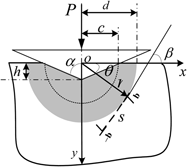Crossref Citations
This article has been cited by the following publications. This list is generated based on data provided by
Crossref.
Fang, Q.H.
and
Zhang, L.C.
2013.
Prediction of the threshold load of dislocation emission in silicon during nanoscratching.
Acta Materialia,
Vol. 61,
Issue. 14,
p.
5469.
Wang, Yue-cun
Xie, De-gang
Ning, Xiao-hui
and
Shan, Zhi-wei
2015.
Thermal treatment-induced ductile-to-brittle transition of submicron-sized Si pillars fabricated by focused ion beam.
Applied Physics Letters,
Vol. 106,
Issue. 8,
Zhang, Zhenyu
Guo, Liangchao
Cui, Junfeng
Wang, Bo
Kang, Renke
and
Guo, Dongming
2016.
Nanoscale solely amorphous layer in silicon wafers induced by a newly developed diamond wheel.
Scientific Reports,
Vol. 6,
Issue. 1,
Guo, Jiawen
Chen, Jianbin
Li, Jia
Fang, Qihong
and
Liu, Youwen
2016.
Study on subsurface-inclined crack propagation during machining of brittle crystal materials.
Applied Physics A,
Vol. 122,
Issue. 5,
Zhang, Junjie
Zhang, Jianguo
Wang, Zhanfeng
Hartmaier, Alexander
Yan, Yongda
and
Sun, Tao
2017.
Interaction between phase transformations and dislocations at incipient plasticity of monocrystalline silicon under nanoindentation.
Computational Materials Science,
Vol. 131,
Issue. ,
p.
55.
Chen, Jianbin
Fang, Qihong
Du, Jianke
Xie, Chao
and
Liu, Feng
2017.
Impact of process parameters on subsurface crack growth in brittle materials grinding.
Archive of Applied Mechanics,
Vol. 87,
Issue. 2,
p.
201.
Fan, Jinjun
Li, Jia
Huang, Zaiwang
Wen, P.H.
and
Bailey, C.G.
2018.
Grain size effects on indentation-induced plastic deformation and amorphization process of polycrystalline silicon.
Computational Materials Science,
Vol. 144,
Issue. ,
p.
113.
Wu, Zhonghuai
Liu, Weidong
and
Zhang, Liangchi
2018.
Critical loading conditions of amorphization, phase transformation, and dilation cracking in 6H‐silicon carbide.
Journal of the American Ceramic Society,
Vol. 101,
Issue. 8,
p.
3585.
Wang, Peizhi
Ge, Peiqi
Bi, Wenbo
Liu, Tengyun
and
Gao, Yufei
2018.
Stress analysis in scratching of anisotropic single-crystal silicon carbide.
International Journal of Mechanical Sciences,
Vol. 141,
Issue. ,
p.
1.
Dai, Houfu
Li, Shaobo
and
Chen, Genyu
2019.
Molecular dynamics simulation of subsurface damage mechanism during nanoscratching of single crystal silicon.
Proceedings of the Institution of Mechanical Engineers, Part J: Journal of Engineering Tribology,
Vol. 233,
Issue. 1,
p.
61.
Manjula, N.
Selvan, G.
and
Balu, A. R.
2019.
Photocatalytic Performance of SnO2:Mo Nanopowders Against the Degradation of Methyl Orange and Rhodamine B Dyes Under Visible Light Irradiation.
Journal of Electronic Materials,
Vol. 48,
Issue. 1,
p.
401.
Yao, Longxu
Zhang, Lei
Ge, Peiqi
Gao, Yufei
and
Wang, Hui
2020.
Study on nucleation and propagation of median cracks generated by scratching single crystal silicon.
Materials Science in Semiconductor Processing,
Vol. 105,
Issue. ,
p.
104691.
Li, Chen
Zhang, Yong
Zhou, Guangzhe
Wei, Zongjie
and
Zhang, Liangchi
2020.
Theoretical modelling of brittle-to-ductile transition load of KDP crystals on (001) plane during nanoindentation and nanoscratch tests.
Journal of Materials Research and Technology,
Vol. 9,
Issue. 6,
p.
14142.
Jiang, Qianqing
Zhang, Lei
and
Yang, Chunfeng
2021.
Research on material removal mechanism and radial cracks during scribing single crystal gallium nitride.
Ceramics International,
Vol. 47,
Issue. 11,
p.
15155.
Wu, Lei
Cui, Licong
Guo, Jian
Peng, Yong
Zou, Jihua
Yu, Bingjun
and
Qian, Linmao
2022.
Rapid and flexible construction of inverted silicon architectures with nanogaps as high-performance SERS substrates.
Applied Surface Science,
Vol. 594,
Issue. ,
p.
153429.
Cui, Licong
Zhu, Jie
Wang, Jianliang
Chen, Tingting
He, Wang
Qian, Linmao
and
Yu, Bingjun
2023.
Roles of crystal defects in site-controlled preparation of metallic micro/nanostructures on silicon surface.
Sensors and Actuators A: Physical,
Vol. 363,
Issue. ,
p.
114712.
Snopiński, P.
2023.
Exploring microstructure refinement and deformation mechanisms in severely deformed LPBF AlSi10Mg alloy.
Journal of Alloys and Compounds,
Vol. 941,
Issue. ,
p.
168984.
Snopiński, Przemysław
2023.
Electron Microscopy Study of Structural Defects Formed in Additively Manufactured AlSi10Mg Alloy Processed by Equal Channel Angular Pressing.
Symmetry,
Vol. 15,
Issue. 4,
p.
860.
Guo, Yunfa
Zhan, Jiaming
Lu, Wen Feng
and
Wang, Hao
2024.
Mechanism in scratching of calcium fluoride with magneto-plasticity.
International Journal of Mechanical Sciences,
Vol. 263,
Issue. ,
p.
108768.
Li, Zhen
Li, Yifan
and
Zhang, Liangchi
2024.
On the deformation mechanism and dislocations evolution in monocrystalline silicon under ramp nanoscratching.
Tribology International,
Vol. 193,
Issue. ,
p.
109395.


